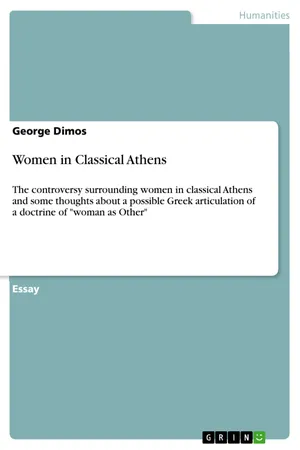
Women in Classical Athens
The controversy surrounding women in classical Athens and some thoughts about a possible Greek articulation of a doctrine of "woman as Other"
- 34 pages
- English
- PDF
- Available on iOS & Android
Women in Classical Athens
The controversy surrounding women in classical Athens and some thoughts about a possible Greek articulation of a doctrine of "woman as Other"
About this book
Essay from the year 1987 in the subject Greek Studies - Literature, language: English, abstract: The text summarizes and examines the five main categories of thought/ research that tried to interpret the man-woman relations in ancient Greece. That is authors that find a 'patriarchal bias', feminist and Marxist scholars; authors that used Freudian tools; feminist writers that analyzed some evidence (leaving aside the Marxist and Freudian stereotypes); and finally the thoughts of Foucault on the issue. Then we discuss issues related to the interpretation or misinterpretations of Plato especially what some authors see as 'contradictory sides of Plato's views about women' that are tied to the distinction he (supposedly) makes between soul and body. We touch the issue of misinterpretation of various Greek myths and also the missing references to the turbulence which characterizes the classical era. Then we conclude that it is beyond doubt that there exists in Ancient Greece a male-female polarity but as most of the findings tend to show, this does not incite any hostility in the relations between the sexes. We then (and given the lack of serious research done on that issue) we proceed guided only by the Lacanian theory of 'Other' to propose a possible Greek articulation of the woman as 'Other'.
Frequently asked questions
- Essential is ideal for learners and professionals who enjoy exploring a wide range of subjects. Access the Essential Library with 800,000+ trusted titles and best-sellers across business, personal growth, and the humanities. Includes unlimited reading time and Standard Read Aloud voice.
- Complete: Perfect for advanced learners and researchers needing full, unrestricted access. Unlock 1.4M+ books across hundreds of subjects, including academic and specialized titles. The Complete Plan also includes advanced features like Premium Read Aloud and Research Assistant.
Please note we cannot support devices running on iOS 13 and Android 7 or earlier. Learn more about using the app.
Information
Table of contents
- INTRODUCTION
- THE CONTROVERSY
- THE WOMAN AS ‘OTHER’
- CONCLUSION
- BIBLIOGRAPHY